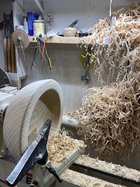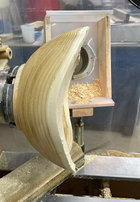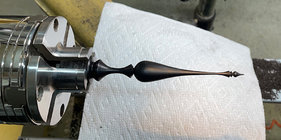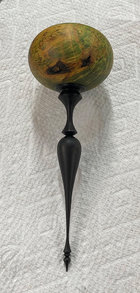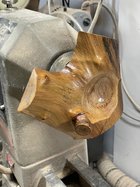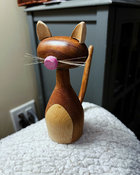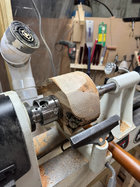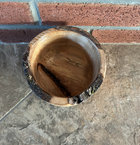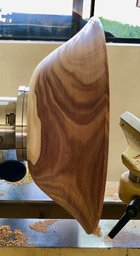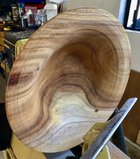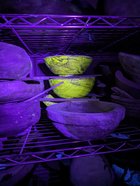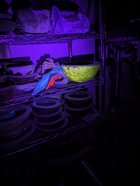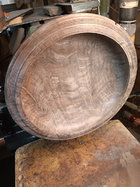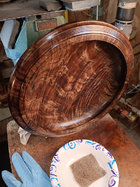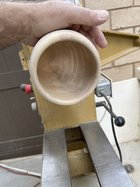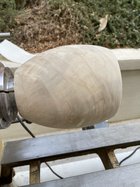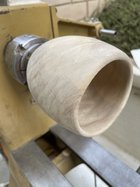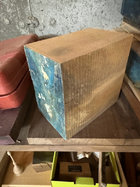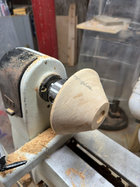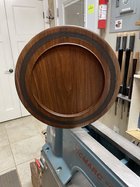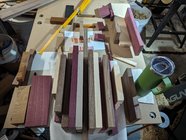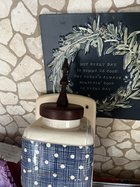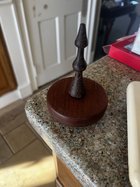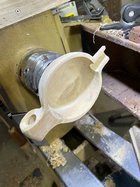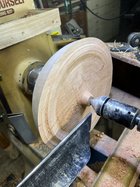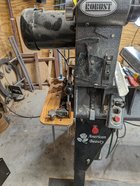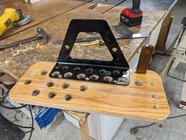Ok. Will do that. Needed a little encouragement and advice, so thanks.shallower recess
-
April 2025 Turning Challenge: Turn an Egg! (click here for details) -
Congratulations to Kelly Shaw winner of the March 2025 Turning Challenge (click here for details) -
Congratulations to Guillaume Fontaine for "Nebules" being selected as Turning of the Week for April 6, 2025 (click here for details) -
Welcome new registering member. Your username must be your real First and Last name (for example: John Doe). "Screen names" and "handles" are not allowed and your registration will be deleted if you don't use your real name. Also, do not use all caps nor all lower case.
You are using an out of date browser. It may not display this or other websites correctly.
You should upgrade or use an alternative browser.
You should upgrade or use an alternative browser.
What’s on your lathe?
- Thread starter Rusty Nesmith
- Start date
ASH!
Ash is what’s on my lathe….and my floor, and my lights, and behind my ears, and in my beard. Roughed out 17 bowls today, all 12-16“. Sheesh.
The mess will have to wait until tomorrow, got a hot tub date with the boss to watch the meteor shower!
Ash is what’s on my lathe….and my floor, and my lights, and behind my ears, and in my beard. Roughed out 17 bowls today, all 12-16“. Sheesh.
The mess will have to wait until tomorrow, got a hot tub date with the boss to watch the meteor shower!
Attachments
Last few days, I've been working on a bowl made from Pau Santo, also known as Brazilian Blackheart. I have to categorize this wood among the densest and most difficult woods I've ever turned! It was extremely difficult to get a nice clean cut on this one. Glad it turned out ok, because I've never turned this wood before.....and it is the first of several blocks of Pau Santo that I purchased. They have all been roughed out, and are in the seasoning process now......all of them have trouble with cracking, very much like B&W Ebony. It has been, and is a frustrating learning process to deal with this wood.
The beauty of this wood is very satisfying......we'll see how the others turn out!
 www.wood-database.com
www.wood-database.com
-o-
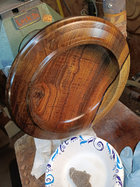
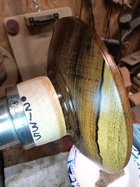
The beauty of this wood is very satisfying......we'll see how the others turn out!
Pau Santo | The Wood Database (Hardwood)
-o-


Wow, impressive! I am lucky to rough out 3 14-16 inch bowls a day Do you core any? What's your process? How many hours did you put in 24? Great job. Love the roughing process.ASH!
Ash is what’s on my lathe….and my floor, and my lights, and behind my ears, and in my beard. Roughed out 17 bowls today, all 12-16“. Sheesh.
The mess will have to wait until tomorrow, got a hot tub date with the boss to watch the meteor shower!
Ash. First time I’ve turned one with a big defect like this. One coat of PTO so far. About 5 1/2 inch diameter.
That's not a defect, it's a beauty mark.
ASH!
Ash is what’s on my lathe….and my floor, and my lights, and behind my ears, and in my beard. Roughed out 17 bowls today, all 12-16“. Sheesh.
The mess will have to wait until tomorrow, got a hot tub date with the boss to watch the meteor shower!
No one talks about the scoop shovel as a required shop tool.
I keep one in the corner. Essential tool. And one of those little metal leaf rakes for kids. Works great for getting the wet shavings onto the shovel.No one talks about the scoop shovel as a required shop tool.
I have found with madrone/arbutus, that I get less cracking if the wood/tree has the spring sap running.
robo hippy
robo hippy
Had about 8 hours from the first cut with the chainsaw to the last bowl in the kiln. This was very clear ash that had only been sitting since September, so it was nice and soft. Makes roughing a real pleasure. I have never explored coring, mostly due to the abundance of material on my property, but also because it sounds like hard work. I saw out the sweet stuff and chuck the rest in the wood stove. Once roughed, the bowls go right into the kiln, no coatings. 6-8 weeks later, I pull them out, I pile them up and let them sit a few months before second turning.Wow, impressive! I am lucky to rough out 3 14-16 inch bowls a day Do you core any? What's your process? How many hours did you put in 24? Great job. Love the roughing process.
Making a kitty cat
View attachment 58408
Attachments
Looks like Mulberry to me Jay.
James Seyfried just posted a picture of BlackAcacia, post 1924 up here.
Leo,
Usually, I could never disagree with anyone who identifies a tree contrary to my opinion except in one or two very rare occasions. This bowl was first pictured in my post on this thread #28 and then again in #261, “my first coring”. It was from a tree that fell from The Dallidet Adobe property into the parking lot for my office. The tree was identified by the Arborist for the Dallidet Adobe who is also a Cal Poly professor as “Acacia Melanoxylon”. I have to stick to my identification as “Black Acacia.
Jay
Usually, I could never disagree with anyone who identifies a tree contrary to my opinion except in one or two very rare occasions. This bowl was first pictured in my post on this thread #28 and then again in #261, “my first coring”. It was from a tree that fell from The Dallidet Adobe property into the parking lot for my office. The tree was identified by the Arborist for the Dallidet Adobe who is also a Cal Poly professor as “Acacia Melanoxylon”. I have to stick to my identification as “Black Acacia.
Jay
The Black Locust Melanoxylon is the Australian Black Locust and a invasive species, we do have Native Black Locust also, the bark of these species are very different to each other, as seen here in these two pictures.Leo,
Usually, I could never disagree with anyone who identifies a tree contrary to my opinion except in one or two very rare occasions. This bowl was first pictured in my post on this thread #28 and then again in #261, “my first coring”. It was from a tree that fell from The Dallidet Adobe property into the parking lot for my office. The tree was identified by the Arborist for the Dallidet Adobe who is also a Cal Poly professor as “Acacia Melanoxylon”. I have to stick to my identification as “Black Acacia.
Jay
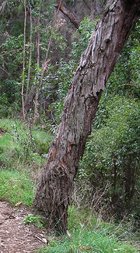
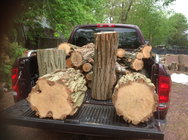
To positive ID these as Black Locust, you can use UV light and see it glow, as for Mulberry, it looks a lot like Black Locust but it does not glow under UV light.
Here is some reason that Mulberry is ID'd as Black Locust.
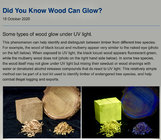
To me Mulberry does look different than Black Locust, anyway I wanted to make sure other turners do not get confused with the looks of Mulberry that got ID as Black Locust in that post.
BTW Black Locust is a slow growing tree, where Mulberry will often grow fast, this one grow quite fast.
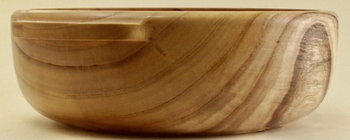
Leo,
Photo of the leaves from the California Invasive Plant Council:
Acacia melanoxylon
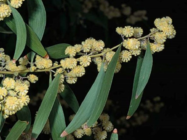
Photo: Joseph DiTomaso
Common names: blackwood Acacia
Acacia melanoxylon (black Acacia) is a tree (family Fabaceae) found along the coast of California, in the North and South Coast Ranges, and the San Francisco Bay region. It favors disturbed areas, and is often found near buildings and agricultural sites. Black Acacia, which has spherical cream-colored flowers, was introduced as a landscape ornamental and has escaped cultivation in some areas. It is native to south eastern Australia. Black Acacia trees can develop root suckers that grow to become large clonal populations. The trees also reproduce using seeds that are dispersed by water movement and human activities. To control mature trees, most root fragments must be removed to prevent resprouting.
The bark looked like this.
From https://selectree.calpoly.edu/tree-detail/28
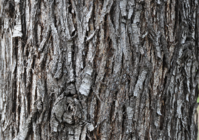
I don't have the ability to check it under black light.
Jay
Photo of the leaves from the California Invasive Plant Council:
Acacia melanoxylon

Photo: Joseph DiTomaso
Common names: blackwood Acacia
Acacia melanoxylon (black Acacia) is a tree (family Fabaceae) found along the coast of California, in the North and South Coast Ranges, and the San Francisco Bay region. It favors disturbed areas, and is often found near buildings and agricultural sites. Black Acacia, which has spherical cream-colored flowers, was introduced as a landscape ornamental and has escaped cultivation in some areas. It is native to south eastern Australia. Black Acacia trees can develop root suckers that grow to become large clonal populations. The trees also reproduce using seeds that are dispersed by water movement and human activities. To control mature trees, most root fragments must be removed to prevent resprouting.
The bark looked like this.
From https://selectree.calpoly.edu/tree-detail/28

I don't have the ability to check it under black light.
Jay
The Black Locust Melanoxylon is the Australian Black Locust and a invasive species, we do have Native Black Locust also, the bark of these species are very different to each other, as seen here in these two pictures.
To positive ID these as Black Locust, you can use UV light and see it glow, as for Mulberry, it looks a lot like Black Locust but it does not glow under UV light.
Here is some reason that Mulberry is ID'd as Black Locust.
View attachment 58498
To me Mulberry does look different than Black Locust, anyway I wanted to make sure other turners do not get confused with the looks of Mulberry that got ID as Black Locust in that post.
BTW Black Locust is a slow growing tree, where Mulberry will often grow fast, this one grow quite fast.
I experienced the glow night before last, it was pretty neat. I had been messing with some uv epoxy and had my black light flashlight in the shop. I happened to turn the lights off and shined the flashlight around and it had been awhile since I turned the black locust but apparently I didn't get it swept up well because little glowing chips on the floor and the four bowls I turned were glowing yellow on the rack.
Attachments
- Joined
- Apr 27, 2004
- Messages
- 9,152
- Likes
- 5,757
- Location
- Lakeland, Florida
- Website
- www.hockenberywoodturning.com
.tear out killing me today despite various efforts. Shellac next. And lots more sanding.
The deep forms are harder to do because of the issue they create with keeping the bevel on the wood
You might Practice with hemisphere bowls wider than tall.
What tools are you using. I find that a 3/8 diameter bar gouge makes a cleaner surface near the rim than my regular bowl gouge.
used a bunch trying to smooth surface: round nose scraper, failed w neg rake scraper, used 1/2 inch bowl gouge, Hunter Osprey. And 60 and 80 grit abrasives.
I would try a good coat of sanding sealer then try the negative rake with a fresh bur again. Sealer should help hold the fibers so the can cut cleaner.used a bunch trying to smooth surface: round nose scraper, failed w neg rake scraper, used 1/2 inch bowl gouge, Hunter Osprey. And 60 and 80 grit abrasives.
For what its worth, I’ve been making a pilgrimage once or twice a year for the last several years to a good friend’s home on the central California coast to pick up as much black acacia as I can cram into my conveyance…I can assure you the wood Jay has pictured is, indeed, black acacia. It’s a wonderful wood to turn and is also informally known as California Koa. I fully trust the arborists who harvest it to correctly identify what they’ve felled and my friend who has spent the past 40 years millling it and designing/creating and selling award-wiNing custom furniture and cabinetry in one of the highest-end markets in the country.Leo,
Photo of the leaves from the California Invasive Plant Council:
Acacia melanoxylon
Last edited:
I would try a good coat of sanding sealer then try the negative rake with a fresh bur again. Sealer should help hold the fibers so the can cut cleaner.
^^^^^Without improving anything about how sharp the edge is, or how that edge is presented, Gary probably has a solution that would improve the quality of Alan's cut.
My first reaction to seeing torn grain, is to make the sharpness of the cutting edge a little keener, first and foremost.....then, consider the presentation.
-o-
- Joined
- Apr 27, 2004
- Messages
- 9,152
- Likes
- 5,757
- Location
- Lakeland, Florida
- Website
- www.hockenberywoodturning.com
used a bunch trying to smooth surface: round nose scraper, failed w neg rake scraper, used 1/2 inch bowl gouge, Hunter Osprey. And 60 and 80 grit abrasives.
Check your tool rest height. I set the tool rest so I’m cutting at center with the gouge level.
Then lower the handle so I’m always cutting above or at center.
Some woods especially wet woods don’t scrape well. I make sure scraping is improving the surface.
If you have a 1/4” bowl gouge(3/8 bar dia) try that. Use I use a 45 degree bevel traditional grind.
Leaves a much cleaner surface than a larger gouge.
Brain didn't work today. I made the inside bigger than the outside! Haven't done that in a while! I was able to salvage a small 3x1 bowl out of it. LOL.
... tree was identified by the Arborist for the Dallidet Adobe who is also a Cal Poly professor as “Acacia Melanoxylon”. I have to stick to my identification as “Black Acacia.
Jay
Definitely Acacia Melanoxylon. I'm very familiar with it as it is the local wood that I mostly work with. We call it Blackwood down this way. Haven't ever observed it glowing under UV light, but it has been rated as having the most chatoyance of any wood by the group that studies that... https://www.chatometry.com/
The richness of its colour depends in part from the soil it is growing in. Here it grows in balance with other indigenous species, but
do everything you can to eradicate it if it has become a weed tree the way our eucalypts have become feral on the west coast of the USA.
That anything like the Tardis bowl?Brain didn't work today. I made the inside bigger than the outside! Haven't done that in a while! I was able to salvage a small 3x1 bowl out of it. LOL.
I’d say that is about as close to perfect form that I have ever seen. I find free curve to be beautiful. Stunning.The second turning for this Ash calabash form, about 10” diameter. I love the lightness of this bowl, and want to keep it as non-yellow as possible. So, I’ll be making my first attempt at two part wood bleach. Not sure what after that for a protective finish.
View attachment 58123View attachment 58118View attachment 58124
Here is my current project. My wife wanted a serving platter. This one is 18” in diameter and the center section is 12”-big enough to hold lots of Christmas cookies ! I am a bit disappointed with my attempt at texturing, but overall I think it turned out OK. I should be able to finish it up today.
Attachments
Been turning salt pigs lately - they make nice gifts this time of year. Black Acacia nearly finished up front, roughed out behind. African Blackwood inset on the lid. NW Bitter Cherry behind that tied together to dry with some black locust back there somewhere. These are designed to be one-handed - the lid swings easily out of the way with a gentle push. That way you can get to the salt (or any spice you use a lot) while stirring or holding the pot lid in the other hand. I leave all the wall thickness I can to make them heavy enough to stay put while using.


